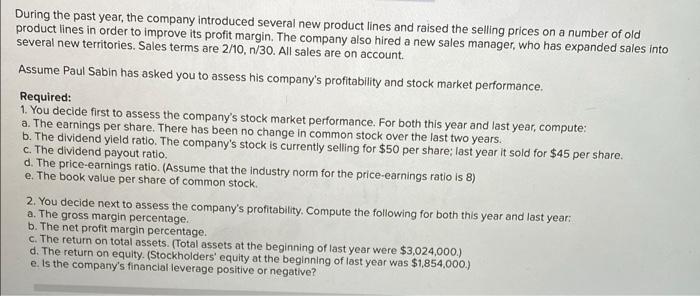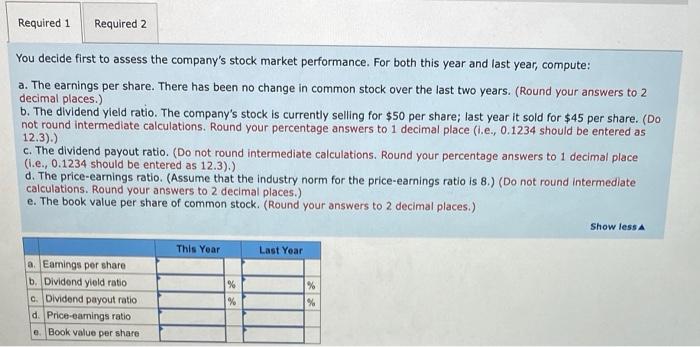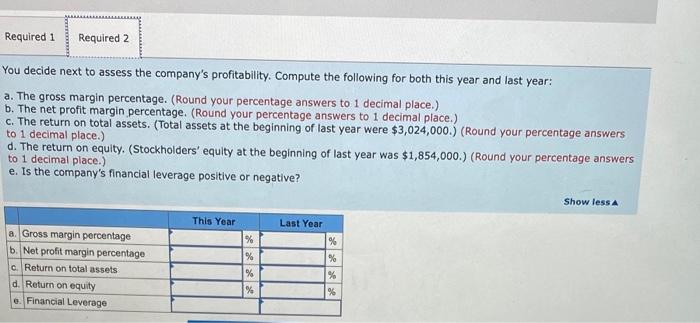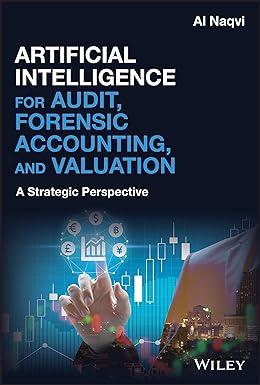Answered step by step
Verified Expert Solution
Question
1 Approved Answer
9. plese help 2 required thank you Vita Comparative Balance Sheet This Year Last Year Assets Current assets: Cash Marketable securities Accounts receivable, net Inventory
9. plese help 2 required thank you 



Vita Comparative Balance Sheet This Year Last Year Assets Current assets: Cash Marketable securities Accounts receivable, net Inventory Prepaid expenses Total current assets Plant and equipment, net Total assets Liabilities and Stockholders Equity Liabilities: Current liabilities Bonds payable, 12% Total liabilities Stockholders' equity: Common stock, $15 par Retained earnings Total stockholders' equity Total liabilities and stockholders' equity $ 130,000 @ 672,000 1,095,000 34,000 1,931,000 2,099,400 $ 4,030,400 300,000 12,000 450,000 745,000 37,000 1,544,000 1,520,000 $3,064,000 $ 875,000 750,000 1,625,000 $ 450,000 750,000 1,200,000 840,000 1,565,400 2,405,400 $ 4,030,400 840,000 1,024,000 1,864,000 $3,064,000 Sabin Electronics Comparative Income Statement and Reconciliation This Year Last Year Sales $5,750,000 $ 4,800,000 Cost of goods sold 4,025,000 3,600,000 Gross margin 1,725,000 1,200,000 Selling and administrative expenses 683,000 578,000 Net operating income 1,042,000 622,000 Interest expense 90,000 90,000 Net income before taxes 952,000 532,000 Income taxes (304) 285,600 159,600 Net income 666,400 372,400 Common dividends 125,000 104,000 Net income retained 541,400 268,400 Beginning retained earnings 1,024,000 755,600 Ending retained earnings $ 1,565, 400 $ 1,024,000 During the past year, the company introduced several new product lines and raised the selling prices on a number of old product lines in order to improve its profit margin. The company also hired a new sales manager, who has expanded sales into several new territories. Sales terms are 2/10,n/30. All sales are on account. Assume Paul Sabin has asked you to assess his company's profitability and stock market performance. Required: 1. You decide first to assess the company's stock market performance. For both this year and last year, compute: a. The earnings per share. There has been no change in common stock over the last two years. b. The dividend yield ratio. The company's stock is currently selling for $50 per share; last year it sold for $45 per share. c. The dividend payout ratio. d. The price-earnings ratio. (Assume that the industry norm for the price-earnings ratio is 8) e. The book value per share of common stock 2. You decide next to assess the company's profitability. Compute the following for both this year and last year, a. The gross margin percentage. b. The net profit margin percentage. c. The return on total assets. (Total assets at the beginning of last year were $3,024,000.) d. The return on equity. (Stockholders' equity at the beginning of last year was $1,854,000.) e. Is the company's financial leverage positive or negative? Required 1 Required 2 You decide first to assess the company's stock market performance. For both this year and last year, compute: a. The earnings per share. There has been no change in common stock over the last two years. (Round your answers to 2 decimal places.) b. The dividend yield ratio. The company's stock is currently selling for $50 per share; last year it sold for $45 per share. (Do not round Intermediate calculations. Round your percentage answers to 1 decimal place (I.e., 0.1234 should be entered as 12.3).) c. The dividend payout ratio. (Do not round intermediate calculations. Round your percentage answers to 1 decimal place (i.e., 0.1234 should be entered as 12.3).) d. The price-earnings ratio. (Assume that the industry norm for the price-earnings ratio is 8.) (Do not round Intermediate calculations. Round your answers to 2 decimal places.) e. The book value per share of common stock. (Round your answers to 2 decimal places.) Show less This Year Last Year % a. Earnings por share b. Dividend yield ratio c. Dividend payout ratio d. Price-eamings ratio eBook value per share % % % Required 1 Required 2 You decide next to assess the company's profitability. Compute the following for both this year and last year: a. The gross margin percentage. (Round your percentage answers to 1 decimal place.) b. The net profit margin percentage. (Round your percentage answers to 1 decimal place.) c. The return on total assets. (Total assets at the beginning of last year were $3,024,000.) (Round your percentage answers to 1 decimal place.) d. The return on equity. (Stockholders' equity at the beginning of last year was $1,854,000.) (Round your percentage answers to 1 decimal place.) e. Is the company's financial leverage positive or negative? Show less Last Year % a. Gross margin percentage b. Net profit margin percentage c. Return on total assets d. Return on equity e Financial Leverage This Year % % % % % % % 



Step by Step Solution
There are 3 Steps involved in it
Step: 1

Get Instant Access to Expert-Tailored Solutions
See step-by-step solutions with expert insights and AI powered tools for academic success
Step: 2

Step: 3

Ace Your Homework with AI
Get the answers you need in no time with our AI-driven, step-by-step assistance
Get Started


